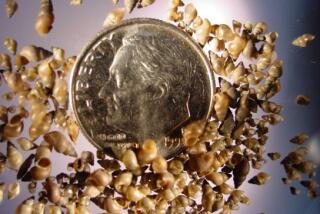Florida on guard against giant snails
- Share via
Reporting from Orlando, Fla. — They’re not as menacing as Burmese pythons proliferating in the Everglades, but giant African snails are targets of the government too.
The invasive mollusks are considered a major plant pest and a potential public health threat because they can spread diseases, including meningitis. Now federal and state authorities are seeking to prevent the large, slimy, shell-toting snails from reestablishing themselves in Florida.
Once established, agricultural officials said, the mollusks “can create a giant swath of destruction.”
“The idea is that these are prolific breeders,” said Mark Fagan, spokesman for the Florida Department of Agriculture and Consumer Services. “Our primary concern is the potential harm it can do to agricultural crops, as well as [public] health concerns.”
The Florida department, the U.S. Department of Agriculture and the U.S. Fish and Wildlife Service are leading the mollusk-prevention effort.
Known as Achatina fulica, the species is one of the world’s largest land snails. They can grow to 8 inches long and 4.5 inches in diameter. It is illegal to import the snails into the United States without a permit.
The snail has not been an issue in Florida for several decades. In 1966, a child smuggled three snails into the Miami area as pets. His grandmother later released them into a garden, and by 1973, the population had grown to more than 18,000, officials said.
Over the next decade, officials spent more than $1 million to eradicate them. That effort is considered the only successful giant African snail eradication on record.
Scientists say the snails consume at least 500 kinds of plants, including citrus crops, Fagan said.
They also can damage buildings by consuming plaster, stucco and other materials they need to grow their shells.
They carry parasites and worse. “These snails are known to carry meningitis bacteria, so it’s also a health concern,” Fagan said.
The snails are identified by seven to nine whorls, or spirals. They have a brownish shell covering half the length of their bodies. They live as long as nine years and have female and male reproductive organs.
After mating, each snail can produce 100 to 400 eggs. Mated adults lay about 1,200 eggs a year.
The snails originate in East Africa. Officials say they have been introduced into Caribbean islands such as Martinique and Guadeloupe, and they have been detected in Saint Lucia and Barbados.
Fagan said multiple snails were found in February at one property in Hialeah, Fla. Authorities searched the nearby area, but no other snails turned up, he said.
Last year, state and federal wildlife officials began a concerted effort to prevent the spread of pythons in and around the Everglades because those invasive reptiles prey on native species.
Fagan said it’s difficult to compare the dangers posed by two species. “The snakes pose a completely different threat to nature,” he said. “I don’t think you can compare the two.”
acolarossi@ orlandosentinel.com
More to Read
Sign up for Essential California
The most important California stories and recommendations in your inbox every morning.
You may occasionally receive promotional content from the Los Angeles Times.













